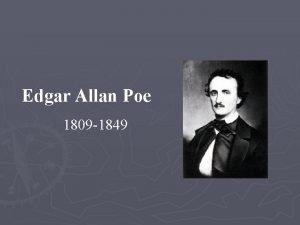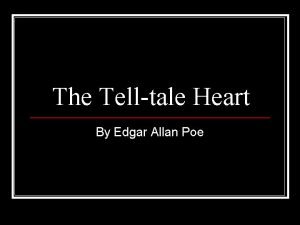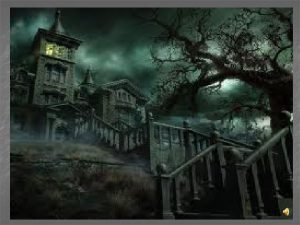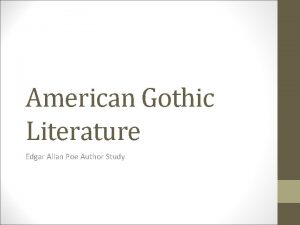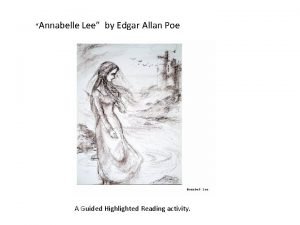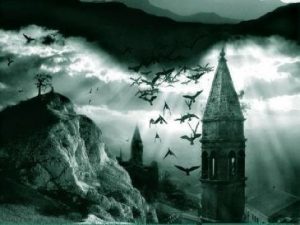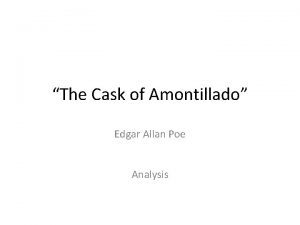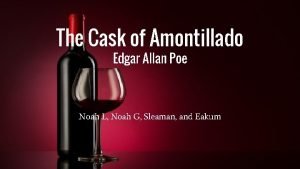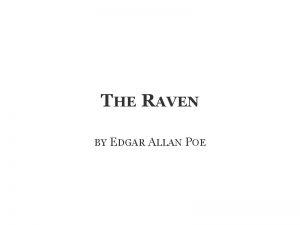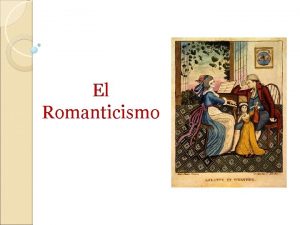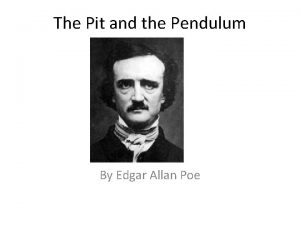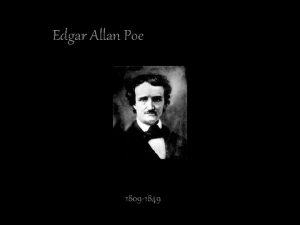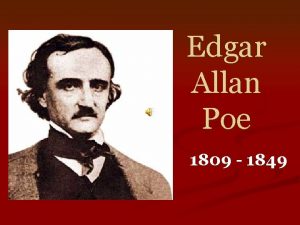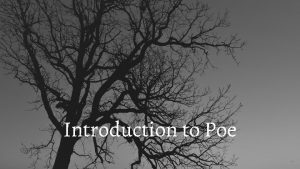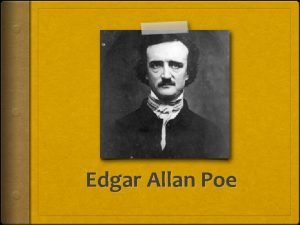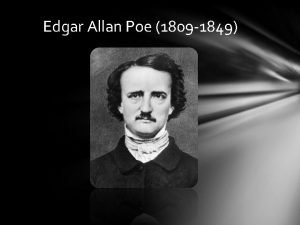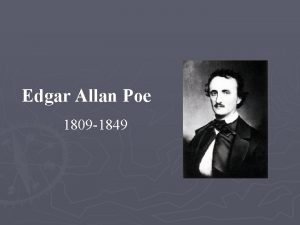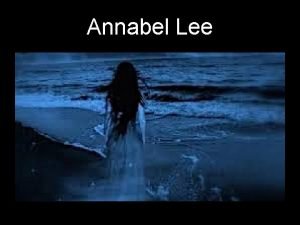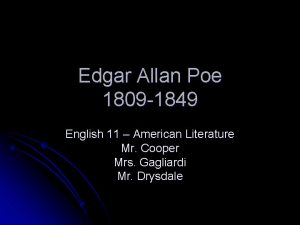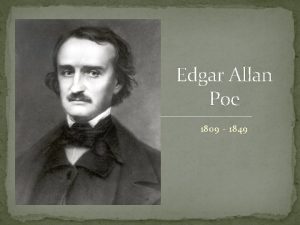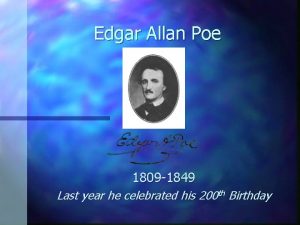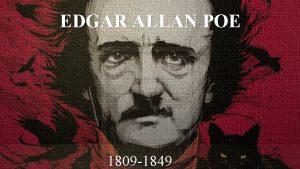Edgar Allan Poe 1809 1849 Edgar Allan Poe



























- Slides: 27

Edgar Allan Poe 1809 -1849

Edgar Allan Poe n n n Born in Boston on January 19, 1809 Mother, Elizabeth Arnold Poe, was a successful actress Father, David Poe, Jr. , was a less successful actor due to alcoholism

Edgar Allan Poe n n n Poe’s father abandoned his family around the time of his 2 nd birthday Elizabeth Poe took Edgar and his 2 siblings, William Henry and Rosalie, to Richmond, VA in 1811, where she died later the same year Poe was separated from his siblings and placed in the care of a childless couple, John and Frances Allan (Poe was never leagally adoped by the couple)

Edgar Allan Poe n n John Allan was a Scottish/English merchant who kept a tight hold on the family’s purse strings, but also recognized the value of education In 1815 he took his wife and Poe on an extended business trip to England In England, Poe spent his childhood at prestigious boarding academies It was in England that Poe first became acquainted with the Gothic literature that was popular in Europe at the time

Edgar Allan Poe n n n The Allans returned to Virginia in 1820, where Poe continued his education at private schools Poe was an excellent student and a superior swimmer and marksman, but he was not popular He was made fun of for being the son of 2 actors (a disreputable occupation) and an unadopted stepson of the Allans

Edgar Allan Poe n n n Poe received support and encouragement from the mother of a classmate, Jane Stith Stanard, but she died of a brain tumor when he was fifteen years old More so than Elizabeth Poe or Mrs. Allan, he looked upon this woman as his idealized mother, and her untimely death was the apparent cause of his first extended period of psychological depression, during which he often visited her grave Around this time, John Allan's trading firm suffered a series of financial setbacks, the company itself was dissolved, and Poe's stepfather took to extramarital affairs and to the bottle

Edgar Allan Poe n n n In 1825, John Allan inherited a large sum of money, and this abrupt reversal of fortune enabled him to enroll Edgar at the University of Virginia Shortly before his departure for college, Poe began to court a fifteen-year-old woman named Sarah Elmira Royster Whether the two were engaged before he left for college is unclear; that he was serious about his intention to marry Sarah is fairly certain

Edgar Allan Poe n n Poe entered the University of Virginia in 1826 at the age of seventeen, concentrating on classical and modern languages He found it difficult to maintain a gentleman's life style on the relatively meager allowance that John Allan furnished to him so he took to gambling and compiled debts of honor amounting to some $2, 000, an enormous sum in the 1820 s John Allan refused to pay these debts; Poe left school and returned to Richmond, where he worked for a time in Allan's counting house When he tried to renew his courtship of Sarah Royster, her parents first told him that she was abroad; he eventually learned that his first fiancée had become engaged to another young man

Edgar Allan Poe n n n Alienated from his stepfather and rejected by Sarah's family, the headstrong Poe set out on his own, moving first to Baltimore in March 1827 and then back to the city of his birth, Boston, where he took the first of several pseudonyms, calling himself Henri Le Rennet It was in Boston that Poe wrote the first poems that would eventually bear his real name Without a regular source of income, Poe joined the army at the age of eighteen, enlisting under the fictitious name of Edgar A. Perry

Edgar Allan Poe n n n While he was stationed at Fort Independence, Poe prevailed upon a local publisher to print his first volume of verses, Tamerlane and Other Poems. By a Bostonian, in 1827 under the name of Edgar Perry To these, he would eventually add six new poems for a volume that would be published in Baltimore under his real name at the end of 1829 By then, however, tragedy struck Poe's life once more: in February 1829, Poe's stepmother, Frances Allen, died, the third mother figure in his life to suffer an untimely death

Edgar Allan Poe n n n The death of Frances Allan set the stage for reconciliation between Poe and John Allan Poe entered West Point in July 1830, but a few months later, he learned that John Allan had remarried a woman with children and realized that he would never receive any inheritance from his stepfather Poe resumed his losing ways at cards, drank heavily, and neglected his duties, refusing to leave his room at the Academy for days on end: he was dismissed from West Point in March 1831 Poe took up residence at the home of his aunt, Maria Clemm, with her young daughter (and Poe's cousin), Virginia Clemm, and Poe's paternal grandmother, Elizabeth Poe Shortly thereafter, he brought out a third slim volume of poems; like its predecessors, this third book was comprised of verses on conventional romantic subjects, notably the myth of an idealized world of beauty and joy recaptured as dreams and memories. Unfortunately, like his first two collections, it failed to receive any reviews. Poe applied for editorial and teaching positions but was unsuccessful in his effort to gain regular employment.

Edgar Allan Poe n n n In 1831, Poe entered into a new stage in his fledgling literary career The tastes of the American reading public had turned from romantic poetry and toward humorous and satirical prose By June of that year, he had submitted five comic pieces to the Philadelphia Saturday Courier Poe received entree to the Southern Literary Messenger, in which he published his first true horror story, "Berenice, " in 1835 Shortly thereafter, he became an editor of this journal, to which he would contribute additional tales, poetry, and scores of book reviews Many of the latter were extremely abrasive; having secured a permanent position in the literary world, Poe quickly made enemies that would come back to haunt him, even after his death

Edgar Allan Poe n n n When John Allan took ill in 1834, Poe traveled to Richmond in the hope of some positive resolution of his conflict with his erstwhile stepfather The dying man, however, would have none of it and refused to see Poe A year later, Poe’s grandmother, Elizabeth Poe, died and Poe moved from Baltimore back to Richmond with his aunt and cousin On May 16, 1836, Poe married his cousin Virginia Clemm, who was just thirteen years old at the time Poe, his bride, and his mother-in-law then moved to New York City, where they would remain for about 18 months before relocating again, this time to Philadelphia

Edgar Allan Poe n n The year 1837 marked the start Poe's most productive period as a fiction writer; during the next eight years, Poe composed most of the tales of terror with which he is customarily identified In 1840, Poe financed the publication of twenty-five short stories as Tales of the Grotesque and Arabesque. But sales of this volume were surprisingly poor; its appearance was neglected by other reviewers, many of whom Poe had already alienated through his criticism of their talents and tastes After several unsuccessful attempts at full-time employment, in 1842, his young wife, Virginia, suffered a burst blood vessel and contracted tuberculosis In March 1843, he went to Washington, D. C. , in search of a job with the federal government. But he was waylaid by an extended drinking binge, Poe taking to the bottle with increasing frequency after Virginia became ill

Edgar Allan Poe n n In 1845, Poe's career received two additional boosts The first came after Poe and his family moved back to New York City, taking residence at a cottage in Fordham, and began to write poetry again. It was in New York that he wrote "The Raven. " The poem was a popular sensation, and it gave him a new source of income, reciting his own verses (and later lecturing) to paying audiences During the remaining years of his life, Poe wrote virtually all of his most famous poems The second boost came when James Russell Lowell wrote a laudatory essay about Poe that appeared in Graham's Magazine. With Lowell's assistance, Poe became the editor of the Broadway Journal

Edgar Allan Poe n n n Poe now watched as Virginia's health deteriorated In his own words, he suffered "the horrible, neverending oscillation between hope and despair" On January 30, 1847, Virginia Poe died Poe lapsed into depression and hard drinking He pulled out of this descent, turning to the composition of theoretical works about literature, human nature, and the cosmos at large He became conditionally engaged to the somewhat older Sarah Helen Whitman, but their relationship ended abruptly when he called upon her in a drunken state

Edgar Allan Poe n n n Contrary to popular belief, in his final year (1849), Poe's life was relatively stable He continued to earn a living through his lectures and recital performances, and he visited friends that he had made in Philadelphia, Baltimore, and Richmond In fact, Poe spent two months in Richmond, calling upon Sarah Shelton, who had become a widow and reportedly accepted his proposal of marriage

Edgar Allan Poe n n On October 3, 1849, an election day, Poe was found deliriously ill, lying half-conscious in the street (in Baltimore) outside of a polling place and a few yards away from a tavern Whether Poe was drunk or not has never been conclusively determined He was taken to a local hospital, still in a delirious state and calling for a polar explorer of the day named Reynolds He uttered his final words and epitaph, "Lord help my poor soul, " on October 7, 1849, and was buried the next day in Baltimore's Presbyterian Cemetery

Edgar Allan Poe n n While the enormous popularity of Edgar Allan Poe's famous short stories and poems continues to highlight his creative brilliance, Poe's renown as the master of horror, the father of the detective story, and the voice of "The Raven" is something of a mixed blessing Today, Poe is known, read, and appreciated on the basis of a comparatively narrow body of work, roughly a dozen tales and half as many poems He wrote for the masses, using his learned artistry to reach the common people of his day and to then elevate their minds while intensifying their emotional reactions Along with Mark Twain and Ernest Hemingway, Poe ranks among the foremost literary stars in the firmament of popular American culture. A century and half after his death, Poe is instantly identifiable, stands without rival, and remains (with effort) immensely enjoyable

Edgar Allan Poe n n n Poe, in fact, wrote nearly seventy short works of fiction He is duly credited with creating the detective story genre and with transforming the Gothic mystery tale of the Romantic Period into the modern horror or murder stories centered in the outlying regions of human mind and experience But he also wrote several comic and satirical pieces, literary parodies, sketches, and experimental stories

Edgar Allan Poe n n n Poe developed a theory of composition that he applied to both his short stories and his poems Its most basic principle was that insofar as short fiction and poetry were concerned, the writer should aim at creating a single and total psychological/spiritual effect upon the reader The theme or plot of the piece is always subordinate to the author's calculated construction of a single, intense mood in the reader's or listener's mind, be it melancholy, suspense, or horror There are no extra elements in Poe, no subplots, no minor characters, and no digressions except those that show the madness of deranged first-person ("I") narrators Ultimately, Poe took writing to be a moral task that worked not through teaching lessons, but in simultaneously stimulating his readers' mental, emotional, and spiritual faculties through texts of absolute integrity

Lenore (1831) n n n “Lenore” is a poem reflecting on the death at a young age of the fair Lenore Most likely, the Lenore remembered in this poem is the same who is mourned in “The Raven” “Lenore” is a poem with at least two different speakers The second and fourth stanzas are enclosed in quotation marks; the first and third, while not marked, are clearly spoken by a character or characters, not by an omniscient narrator Beyond the quotation marks and a noticeable shift in tone and attitude, there is no indication who is speaking anywhere in the poem Most critics have assumed that the poem presents a dialogue between Guy De Vere, Lenore’s grieving lover, and the family or priest of the dead woman

Berenice (1835) n n n n The story follows a man named Egaeus who is preparing to marry his cousin Berenice He has a tendency to fall into a periods of intense focus during which he seems to separate himself from the outside world Berenice begins to deteriorate from an unnamed disease until the only part of her remaining healthy was her teeth Egaeus begins to obsess on her teeth Berenice dies and Egaeus continues to contemplate her teeth Deep in thought, he is interrupted by a servant who tells him Berenice's grave has been disturbed Poe was forced to self-censor the work due to its violent nature

Ligeia (1838) n n n Edgar Allan Poe's celebrated "Ligeia"— one of his finest treatments of romantic love frustrated by death—may be a story that asserts the power of the human will; or "Ligeia" may be a story that demonstrates the destructive power of delusions At the story's climax, is Ligeia's resurrection from the dead a supernatural event, or an hallucination by a man demented from obsessive grief and excessive opium, or both? The text of the story supports both readings and has thus inspired a lively debate among literary scholars The two interpretations seem to argue in opposite directions: that the human will is so grand that it can overcome all other forces in its exercise of godlike supernatural power, or that human consciousness is so easy a prey to raw emotion and narcotics that it cannot even perceive what is real Human will is either powerful or puny

The Tell-Tale Heart (1843) n n One of Edgar Allan Poe’s most famous short stories, it is a psychological portrait of a mad narrator who kills a man and afterward hears his victim’s relentless heartbeat It is simultaneously a horror story and psychological thriller told from a first-person perspective It is admired as an excellent example of how a short story can produce an effect on the reader It exemplifies Poe’s ability to expose the dark side of humankind and is a harbinger of novels and films dealing with psychological realism

The Raven (1845) n n Over the course of the nineteenth and twentieth centuries, “The Raven” has become one of America’s most famous poems, partly as a result, of its easily remembered refrain, “Nevermore” The speaker, a man who pines for his deceased love, Lenore, has been visited by a talking bird who knows only the word, “Nevermore” The narrator feels so grieved over the loss of his love that he allows his imagination to transform the bird into a prophet bringing news that the lovers will “Nevermore” be reunited, not even in heaven In “The Philosophy of Composition, ” Poe’s own essay about “The Raven, ” he describes the poem as one that reveals the human penchant for “self-torture” as evidenced by the speaker’s tendency to weigh himself down with grief

Annabelle Lee (1849) n n n Written in 1849, "Annabel Lee" was published the same year, just two days after Poe's death on October 7 Using a melodious narrative form, the speaker laments the death, many years ago, of his beloved young bride Annabel Lee His loss moves him to state that envious angels caused the girl's death to separate the young married couple He tells briefly of her funeral and entombment "in her sepulchre … by the sea" The narrator then reveals that he has been unable to accept their separation; since her death, he has spent night after night at her tomb, an astonishing and perverse example of the immortality of young love
 1849-1809
1849-1809 Edgar allan poe escape room answers
Edgar allan poe escape room answers Anticipation guide tell tale heart
Anticipation guide tell tale heart The tell-tale heart questions and answers
The tell-tale heart questions and answers The conqueror worm
The conqueror worm Edgar allan poe author study
Edgar allan poe author study Alone edgar allan poe
Alone edgar allan poe Edgar allan poe the black cat meaning
Edgar allan poe the black cat meaning Annabel lee summary
Annabel lee summary Questions for cask of amontillado
Questions for cask of amontillado Edgar allan poe literary timeline
Edgar allan poe literary timeline Poe
Poe Denouement of the tell tale heart
Denouement of the tell tale heart The cask of amontillado character
The cask of amontillado character Edgar allan poe carbon monoxide poisoning
Edgar allan poe carbon monoxide poisoning Richard parker edgar allan poe
Richard parker edgar allan poe Edgar allan poe vocabulary
Edgar allan poe vocabulary The cask of amontillado plot summary
The cask of amontillado plot summary Edgar allan poe literary genre
Edgar allan poe literary genre Poe webquest
Poe webquest The tell tale heart round character
The tell tale heart round character Edgar allan poe internet scavenger hunt answers
Edgar allan poe internet scavenger hunt answers Horacio quiroga y edgar allan poe
Horacio quiroga y edgar allan poe Edgar allan poe transcendentalism
Edgar allan poe transcendentalism Eldorado poem meaning
Eldorado poem meaning Characters king lear
Characters king lear Poetas satanicos
Poetas satanicos Edgar allan poe spanish inquisition
Edgar allan poe spanish inquisition
